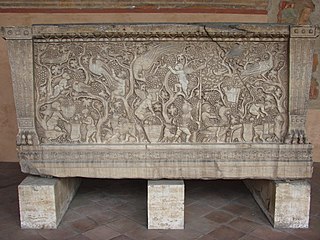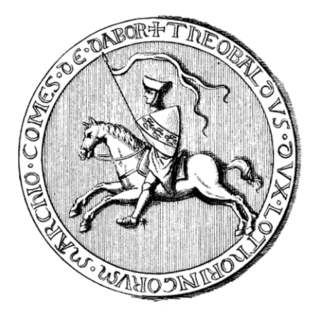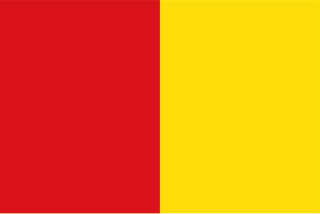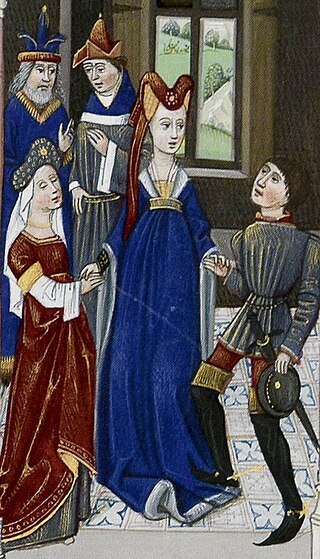
1048 (MXLVIII) was a leap year starting on Friday of the Julian calendar, the 1048th year of the Common Era (CE) and Anno Domini (AD) designations, the 48th year of the 2nd millennium and the 11th century, and the 9th year of the 1040s decade. As of the start of 1048, the Gregorian calendar was 6 days ahead of the Julian calendar, which was the dominant calendar of the time.

The House of Babenberg was a noble dynasty of Austrian Dukes and Margraves. Originally from Bamberg in the Duchy of Franconia, the Babenbergs ruled the imperial Margraviate of Austria from its creation in 976 AD until its elevation to a duchy in 1156, and from then until the extinction of the line in 1246, whereafter they were succeeded by the House of Habsburg.

Theobald I was the duke of Lorraine from 1213 to his death. He was the son and successor of Frederick II and Agnes of Bar.

The Prince-Bishopric of Liège or Principality of Liège was a Roman Catholic ecclesiastical principality of the Holy Roman Empire that was situated for the most part in present-day Belgium. It was an Imperial Estate, so the bishop of Liège, as its prince, had a seat and a vote in the Imperial Diet. The Prince-Bishopric of Liège should not be confused with the Diocese of Liège, which was larger and over which the prince-bishop exercised only the usual responsibilities of a bishop.

The County of Loon was a county in the Holy Roman Empire, which corresponded approximately with the modern Belgian province of Limburg. It was named after the original seat of its count, Loon, which is today called Borgloon. During the middle ages the counts moved their court to a more central position in Kuringen, which today forms part of Hasselt, capital of the province.

Louis II was count of Loon from the end of the 12th century to 1218. He was the son of Gerard, Count of Looz, and Adelaide of Gelderland, daughter of Henry I, Count of Guelders, and Agnes of Arnstein, daughter of Louis III of Arnstein. He also claimed to be the legitimate Count of Holland during the Loon War (1203–1206).

The Battle of Steppes was fought in modern-day Belgium on 13 October 1213 between Hugh Pierrepont, Bishop of Liège, and Henry I, Duke of Brabant.
Count Lambert "the Bearded" was the first person to be described as a count of Leuven in a surviving contemporary record, being described this way relatively late in life, in 1003. He is also the patrilineal ancestor of all the future counts of Leuven and dukes of Brabant until his descendant John III, Duke of Brabant, who died in 1355.

The County of Huy was a comital jurisdiction of Lotharingia during the early Middle Ages, centred on the town of Huy and its citadel overlooking the Meuse.
The County of Metz originated from the frankish Metzgau. In the second half of the 9th century it went to the Gerhardiner (de), which held at the same time the County of Paris.

Arnold IV of Loon (Looz) (died between November 1272 and October 1273; most likely on February 22, 1273), was Count of Loon from 1227 to 1273 and Count of Chiny (as Arnold II) from 1228 to 1268. He was the son of Gérard III, Count of Rieneck and Cunegonde von Zimmern.

Louis I was the Count of Loon, now in modern Belgium, and Burgrave of Mainz, in Germany. He inherited these offices from his father. He also established the County of Rieneck apparently based upon the Burgrave's lands.
Godfrey of Namur was a Lotharingian nobleman. He was Count jure uxoris of Porcéan from 1097 until his death. From 1102, he was also Count of Namur. He was the oldest son of Count Albert III and his wife Ida of Saxony, the heiress of Laroche.
Ermesinde of Luxembourg was a German noblewoman.
The Counts of Chiny were part of the nobility of Lotharingia that ruled from the 9th to the 14th century in what is now part of Belgium.

Arnold V de Looz, was Count of Loon from 1279 to 1323 and Count of Chiny from 1299 to 1310. He was the son of John I, Count of Looz and Mathilde Jülich.
Arnold I, Count of Loon (Looz) from about 1079, son of Emmo, Count of Loon, and Suanhildis, daughter of Dirk III, Count of Holland, and his wife Othelandis.
Count Gerard of Loon, was son and successor of Louis I, Count of Loon, and Agnes of Metz. He was count of Loon and of Rieneck. Because of a widespread misunderstanding concerning a document from 1101, some generations earlier, he is sometimes wrongly referred to as the second Gerard in this dynasty, "Gerard II".
Conon II (Cono) (died 1189 or after), Count of Montaigu and Count of Duras, son of Godefroi, Count of Montaigu, and his wife Julienne, daughter of Otto II, Count of Duras.












